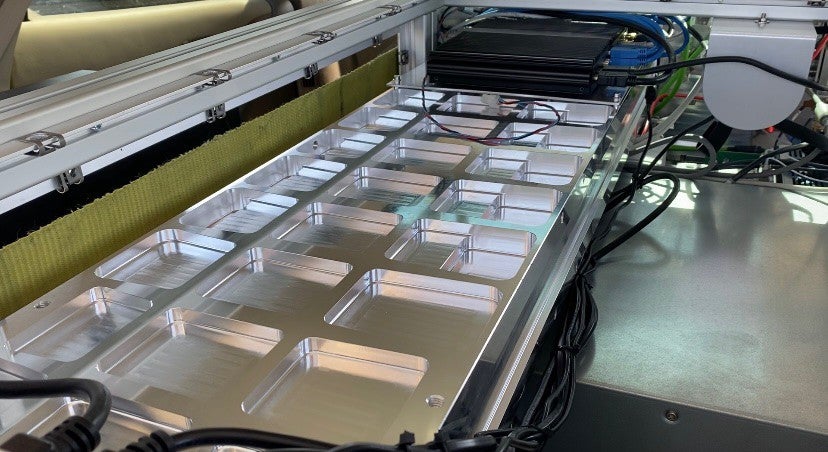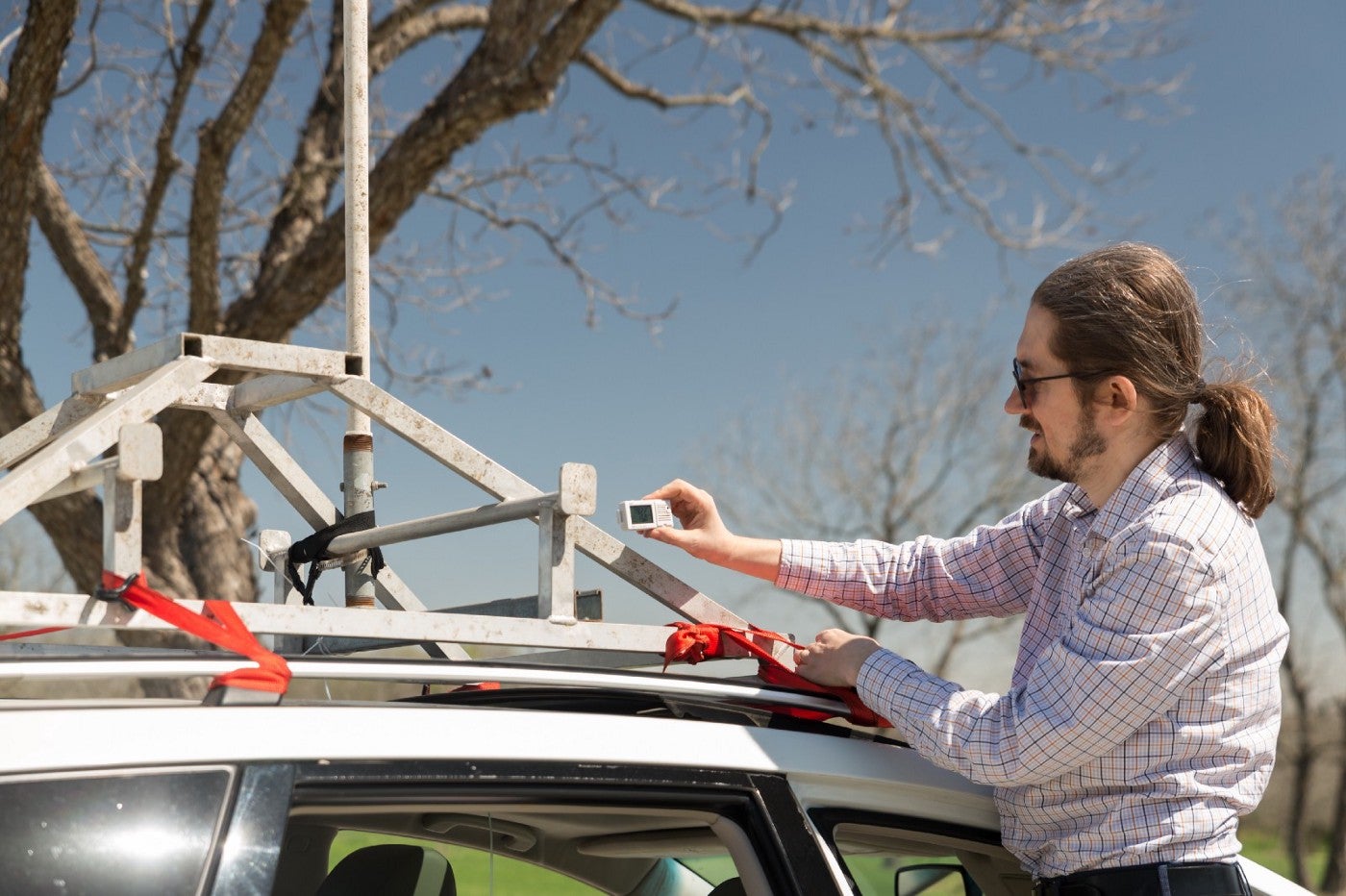
Nitrogen and oxygen make up 99% of the air we breathe, but that’s not all that’s swirling around us as we go about our day. Other compounds like carbon monoxide and nitrogen dioxide, together with fine particles like dust and smoke, can contribute to air pollution that has adverse effects on our health and wellbeing.
And some compounds in our air don’t smell that good, either.
“Starting at 10:00 at night, it starts to smell strongly of fumes,” a mother of two said at a Whole Communities–Whole Health focus group this past December. “When we get up, the smell is still there. I worry because I don’t know if it’s harmful to us.”
She and many others complained of odors in their neighborhoods in eastern Travis County.
Researchers are interested in whether some people are at greater risk of breathing in polluted or odorous air, particularly in communities where people live closer to air pollutant sources such as freeways, the airport, landfills, and industrial facilities.
Now, a new device can help determine that risk.
The University of Texas at Austin recently obtained a Vocus 2R PTR-TOF-MS — a proton transfer reaction time-of-flight mass spectrometer with a detection limit of less than 1 molecule per trillion. Or, as Civil, Architectural and Environmental Assistant Professor Misztal calls it, “the Sniffer.”

It’s a sleek, silver device about 2 feet wide and 5 feet tall that can determine the exact mass of compounds in the air, which allows researchers to figure out their chemical formulas. It’s a thousand times more sensitive than other devices in use, which means it’s top of the line for detecting volatile organic compounds like benzene, furans, and dioxins that may go unnoticed or unindentified but have been linked to adverse health effects, including cancer.
“Just because we cannot see certain compounds doesn’t mean they’re not there,” Misztal explains. He’s been leading a team of researchers using the Vocus to study outdoor odors in Central Texas. “Sometimes we might think the air is clean and safe for the wrong reasons.”
Since the start of the Whole Communities–Whole Health grand challenge initiative, which aims to develop a more complete picture of all the components that influence health from access to healthcare to social supports and environmental factors, some residents in eastern Travis County have reported concerns about air quality, including complaints about potent smells.
Beginning this past January, Misztal and his team have driven the Sniffer, loaded in the back of an SUV, from UT’s J.J. Pickle Research Campus in north Austin to the airport southeast of the city. They wanted to focus, specifically, on places where people have reported odors to determine what those odors are and if they pose any health concerns.
The Sniffer, which looks like a giant computer, is connected to what’s called an inlet, a special pipe that “breathes” in the air from the outdoors. The molecules it collects then travel through the instrument, where they get ionized. A fancy detector gives the full chemical information in a fraction of second, which is reflected on a computer screen near the dashboard in real time. This allows researchers to drive around and map out the entire region for its chemical compounds — something that has never been done before with this kind of instrument.
Misztal says the technology is relatively new (and expensive). Not a lot of people have had the opportunity to use it yet or have felt comfortable putting it in a vehicle and taking it on the road.
In fact, UT owns the only device of this kind in Texas and one of only a handful in the U.S.
“It’s unique,” Misztal says. “You could basically count on your fingers how many institutes have this instrument in the world.”
And operating the device is not a simple push of a button. Reading the data is quite complicated and requires specialized knowledge. Misztal, who has a doctorate in chemistry, has assembled a team of students and other researcherswho have developed processes to crunch the data efficiently and make sense of them.
“There are some exotic compounds we have detected that I have never seen before. It is very difficult to surprise me with compounds I have not seen but I am looking forward to identifying these chemicals to determine if they can accumulate in the environment and if the exposure to the community is significant.”
Misztal explains that, in most studies using gas chromatography — which up until now has been the gold standard for this kind of research, samples collected show only a snapshot of the chemicals in the air at a given time.
“What we are doing now is like taking a chemical video, where you can continually see what molecules are doing and where are they coming from,” he describes. “You combine that with GPS and wind direction data and you can learn about the sources of chemicals and their spatial distribution. You don’t just get the snapshot of information — you get the full picture of how each of these molecules changes over time.”
Seeing how pollutants vary in space and time is critical for understanding people’s exposure to pollution and — in turn — what kind of policies may be needed to improve air quality, Misztal adds.
“We are looking at several hundreds of compounds that constitute pollution plumes,” Misztal says of their work so far taking mobile measurements in Travis County. “I’m concerned about some of them that contain elevated concentrations of air pollutants such as benzene, furans, dioxins, phenols, and others. There are some exotic compounds we have detected that I have never seen before. It is very difficult to surprise me with compounds I have not seen but I am looking forward to identifying these chemicals to determine if they can accumulate in the environment and if the exposure to the community is significant.”
Many air pollutants are not harmful at ultra-low concentrations, Misztal emphasizes, but in a pollution plume, their concentrations can increase substantially. A pollution plume is a contained volume of air with concentrated pollutants traveling with the wind in the atmosphere. As the pollution plume moves away from its source, it widens and eventually gets diluted with the atmosphere. Some pollution plumes are episodic and dissipate very quickly so they are hard to track. However, using real-time mobile sampling coupled with wind measurements, like those collected with the Sniffer, there is a greater chance of being able to capture and track the plumes and their sources.

It’s not always easy to pinpoint a single source, Misztal says. For example, while diesel and gasoline vehicles’ emissions affect most of the city, certain areas are more polluted than others. For example, he explains that in Austin, industrial sources of pollution are not equally distributed. Some areas are more congested, which means there are more cars emitting pollutants. And if you have pollution from jet engines near the airport, you wouldn’t have the same type of pollution on the other side of the city. Doing quality surveys like this one could make it easier to identify where pollution is coming from, giving community organizers the information they need to advocate for new policies to protect areas from potential health risks.
Researchers also plan to pass along their findings to epidemiologists and other health professionals at UT and around the country, who might be able to use the data to determine what the health risk is, if any, from inhaling these chemicals.
The city does have a process for people to report smells — by calling 311 — and they do respond to odor complaints, but they don’t have the needed data to identify where exactly the smells are coming from and if they are of concern.
Currently, the city monitors air quality through a network of sensors the Texas Commission on Environmental Quality (TCEQ) has set up, but UT’s mobile sniffer measurements provide an enhanced look at those compounds second-by-second, which could be much more useful.
Misztal plans to expand his research to other cities that could benefit from the same kind of information.
“I am not aware of anyone else that has done this kind of comprehensive data collection — not with GPS and other sensors to do mobile measurements in real time, which is pretty amazing,” he says. “This initial study is a great start, but there is more to look at in this community and in other communities concerned about what they smell in the air.”
Pawel Misztal, Ph.D., is an assistant professor in the Department of Civil, Architectural and Environmental Engineering. His research interests include understanding the fate, transformations and removal processes of gas-phase aerosol precursors to understand and quantify the role of volatile organic compounds for secondary organic aerosol formation; thinking holistically to understand the feedbacks between anthropogenic pollution, biogenic VOCs and atmospheric chemistry, and their links to climate, food security and health; and interdisciplinary research to quantify the links between atmospheric chemistry, environmental microbiome, and human health

